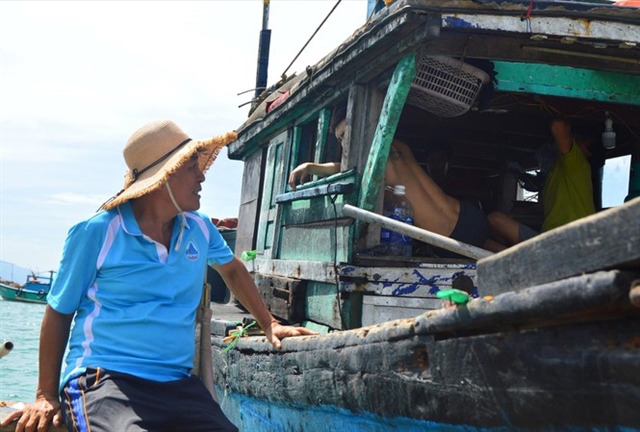 Society
Society

The main task of the team is to tell local fishermen about the Law on Fisheries so that they understand and comply with the law.

|
| Nguyễn Quang, a 55-year-old fisherman, of Liên Chiểu District's Hoà Hiệp Bắc Ward reminds people in a fishing vessel of the permitted-fishing sea water, the prohibited fishing methods and seafood species that should not be caught in the season.—Photo tienphong.vn |
ĐÀ NẴNG — Nguyễn Quang, a 55-year-old fisherman, of Liên Chiểu District's Hoà Hiệp Bắc Ward, Đà Nẵng City, started his working day in the afternoon, as he has every day for the past three years.
Quang took his fishing gear, a loudspeaker and a digital camera wrapped in a nylon bag and put them into his basket boat.
He rowed his small boat to a big motorboat, get on the motorboat then put on a T-shirt, printed with the line “Hoà Hiệp Bắc Ward’s Seafood Resource Protection Team” on the back.
After Quang dropped his net to catch fish, he drove his motorboat to nearby fishing boats to remind them about the permitted fishing areas, prohibited fishing methods and seafood species that should not be caught in the current season.
Quang’s team has 49 members. They often divide into small groups to go on patrol.
The main task of the team is to tell local fishermen about the Law on Fisheries so that they understand and comply with the law.
The team also tells fishermen how to deal with fishing vessels that illegally catch fish or use illegal methods, including blast fishing, electrofishing or bottom trawling.
The team was also tasked with managing coral reefs and protecting coastal seaweed, believed to be a haven for breeding species, he said.
“The sea is vast, we are only assigned to manage two nautical miles near the shore but it is still very big,” he said.
This forces the team to split up and monitor the area they are fishing in. If anything strange is found, they inform inspectors of the city’s Fisheries Sub-department and the border guard force.
Nguyễn Dinh, another fisherman, 67, of Sơn Trà District, has been head of the team to protect Thọ Quang Ward’s Seafood Resource Protection Team for 12 years.
His was the first seafood resource protection team launched in the city in 2008. After the local administration saw the effectiveness of the model, it was used in other districts, Tiền Phong (Vanguard) online newspaper reported.
Dinh said Sơn Trà was the city’s tourist hub, creating many difficulties for managing nearshore coral reefs.
“We have to conduct sea and land patrols,” he said.
When they find a tourist stealing coral under the water, they report to fishermen on land patrol, block the road leading to the coral reef area, catch the violator and them hand them over to authorised agencies, he said.
Currently, the city has four seafood resource protection teams with 94 members in Liên Chiểu, Thanh Khê and Sơn Trà districts.
All the members are fully trained on the law on fisheries, the behaviour of many fish, plants and other sea creatures.
Quang said all of them were born in coastal areas, so they knew the kinds of fish and shrimp in the region well.
However, only after receiving training did they realise the need for balance between exploitation and preservation, he said.
“For example, I often collected seaweed to make fertiliser in the past. But after the training course, I know that seaweed is the home of many species in the breeding season,” he said.
Thanks to seaweed, baby fish and shrimp were born, he said.
Quang also said he joined the team because he wanted to preserve the sea for his descendants.
Dinh said he decided to join the team after he saw the number of fish and shrimp becoming fewer day after day.
Overexploitation and environmental pollution were to blame for the decline of fish and shrimp, Dinh said.
"Myself and many other fishermen understand that sustainable exploitation is the long-term solution for the situation,” he said.
As a result, many fishermen wanted to join the group, he said.
Đặng Duy Hải, deputy head of the city’s Fisheries Sub-department, said the teams were effectively run. They notified violations very timely and accurately.
Statistics of the sub-department showed the teams had found about 300 violations of exploiting nearshore seafood since their establishment.
The teams also gave more than 2,000 leaflets to tourists and local residents to raise public awareness of seafood resource protection, the sub-department said. — VNS









